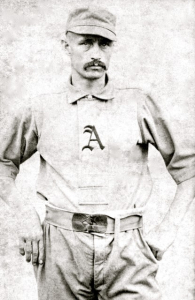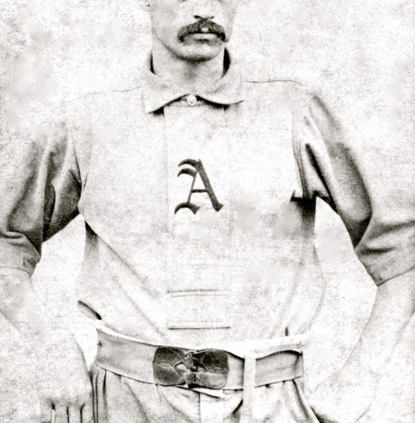September 18, 1883: Harry Stovey establishes new single-season home-run record
 The Tuesday afternoon game at Bank Street Grounds was the middle game of a three-game set between the Philadelphia Athletics and Cincinnati Red Stockings. The two teams and the St. Louis Browns had been locked in a season-long pennant race. As the season wound down, the Athletics, with a record of 62-27, held a 3½-game lead over the Browns. The defending American Association champion Red Stockings, who had fallen off the pace in recent weeks, entered the game in third place with a record of 56-34, 6½ games behind.
The Tuesday afternoon game at Bank Street Grounds was the middle game of a three-game set between the Philadelphia Athletics and Cincinnati Red Stockings. The two teams and the St. Louis Browns had been locked in a season-long pennant race. As the season wound down, the Athletics, with a record of 62-27, held a 3½-game lead over the Browns. The defending American Association champion Red Stockings, who had fallen off the pace in recent weeks, entered the game in third place with a record of 56-34, 6½ games behind.
The pitching matchup featured two of the American Association’s greatest hurlers. Will White drew the starting assignment for the Red Stockings. The bespectacled right-hander was on his way to a winning a league-leading 43 games and leading the circuit with a 2.09 earned-run average. He was opposed by arm-weary Bobby Mathews. The Athletics reluctantly turned to the right-hander after having lost faith in Jumping Jack Jones, who had been knocked around for 11 runs and 13 hits in the series opener, and fear of overworking George Washington Bradley.1 The Athletics’ pitching staff was simply depleted by this point in the season.
The Red Stockings won the coin toss and elected to bat first. With one out in the top of the first, first baseman John Reilly tripled to left and scored on a passed ball. The Athletics responded in a “business-like manner” with five runs in their half of the frame.2 Jud Birchall led off with a single past shortstop and moved to second on a passed ball. Harry Stovey followed with a single to left to score Birchall. Stovey stole second and scored when Lon Knight hit a ball past shortstop that Jimmy Macullar, who was playing in place of sore-armed Chick Fulmer, was too slow to reach. Mike Moynahan followed with a hot liner to second that Bid McPhee only managed to knock down as Knight advanced to second. Jack O’Brien flied out to right, allowing Knight and Moynahan to advance a base. Fred Corey sent an easy fly ball to left that Joe Sommer muffed, allowing another two runs cross the plate. One out later, Cub Stricker singled to drive in the Athletics’ fifth run of the inning.
The score remained 5-1 until the top of third, when Corey sent a long drive to left-center and circled the bases for the first major-league home run of his career. This made the score 6-1 and it stayed that way until the top of the sixth.
The Red Stockings’ White led the sixth off with a single that “curved out of Corey’s reach” at third. The pitcher came around to score when Hick Carpenter sent a fly ball over the head of Birchall in left for a triple. “Reilly next tapped the ball down in front of the plate, but Rowen threw wildly to Stovey, and Stricker in turn fired the ball over Corey’s head, and both ‘Hick’ and Long John came home,” the Cincinnati Enquirer reported.3 This cut the Athletics’ lead to 6-4.
The Athletics answered with four runs in their half of the sixth. Rowan opened the inning with “a tap to Macullar, who, after fumbling it awhile threw wildly to Reilly,” allowing Rowan to reach second.4 Stricker followed with a home run to left-center that was “assisted by slow fielding.”5 After Mathews fouled out to Pop Snyder behind the plate, Macullar failed to come up with Birchall’s hit and was sent to play right field, “where he had the pleasure of chasing Stovey’s hit for a home-run.”6 It was the 14th and final home run of the season for 26-year-old first baseman, who earlier in the year became the first major-league player to hit 10 home runs in a season. The previous record was held by Charley Jones, who hit nine four-baggers in 1879 while playing left field for the Boston Red Stockings of the National League.
Entering the seventh inning, the Athletics appeared to have a safe 10-4 lead. However, with Mathews tiring and some shoddy Athletics defense, Cincinnati mounted a ferocious comeback. McPhee opened with a single to short center and took second on a passed ball. Macullar plated McPhee with a single past shortstop and White, who was given a second and third opportunity after Corey and Birchall missed pop fouls, singled to put runners on first and second. After Carpenter was called out on strikes, on a couple of questionable strike calls by umpire John Kelly, Knight dropped Reilly’s pop fly to right field to load the bases. Jones followed with a bases-clearing triple to right to trim the deficit to 10-8. One out later, Pop Corkhill singled to right to drive in Jones. Corkhill then stole second and scored the tying run when Snyder singled and Moynahan threw wildly to the plate.
With the crowd yelling and cheering wildly, “McPhee brought the spectators up to the highest pitch of enthusiasm by a long hit to left over Birchall’s head on which he made the circuit, bringing Snyder in before him.”7 The inning came to a merciful end when Macullar was retired at first after a dropped third strike. The Red Stockings sent 11 men to the plate and when the dust settled, eight runs crossed the plate and the Red Stockings held a 12-10 lead.
Cincinnati returned the favor with subpar defense of their own in the bottom of the eighth. Mathews reached on an error by Carpenter and hits by Birchall and Moynahan loaded the bases with two outs. O’Brien, who started the game in center field and finished it behind the plate after Rowen’s hands gave out, lofted “an easy fly” to right that Macullar failed to handle, allowing two runs to score. After eight innings the score was tied, 12-12.
Neither team scored in the ninth and the Red Stockings failed to push a run across in their half of the 10th. In the bottom of the inning, Stovey pushed an infield single past White and took second on a passed ball. He moved to third on a fly ball by Moynahan. When a pitch ticked off the hands of Snyder, “Stovey daringly broke for home” and outraced the catcher to the plate with the winning run.8
The slugfest, witnessed by a crowd estimated at 2,000, was, like many games during the era, marred by sloppy defensive work. The Red Stockings got 15 hits off Mathews and the Athletics collected 14 hits.9 The time of the game was 3 hours.10
The loss all but mathematically eliminated the defending champions. With eight games remaining for the Athletics and seven for the third-place Red Stockings, the best Cincinnati fans could hope for was an improbable tie with the Athletics. The Browns edged the New York Metropolitans, 3-2, and remained three games behind the Athletics, setting up a showdown between the Athletics and the Browns in St. Louis. Meanwhile, back in Philadelphia, a mass meeting of citizens was held at the Athletics’ headquarters to begin organizing a reception parade as the city prepared for a much-anticipated championship.11
Stovey’s reign as the single-season home-run leader was short-lived. The next season Ned Williamson, shortstop for the Chicago White Stockings of the National League, slugged 27 home runs to become the new major-league single-season home-run king.12
Sources
In addition to the sources cited in the Notes, the author relied on Baseball-reference.com and Retrosheet.org.
Notes
1 Edward Achorn, The Summer of Beer and Whiskey (New York: Public Affairs Press, 2006), 201.
2 “Stubbornly Fought,” Cincinnati Enquirer, September 19, 1883: 2.
3 “Stubbornly Fought.”
4 “Stubbornly Fought.”
5 “Stubbornly Fought.”
6 “Stubbornly Fought.”
7 “Stubbornly Fought.”
8 Achorn, 201.
9 The box score in the Times (Philadelphia) credits the Athletics with 13 hits.
10 The box score in the Times (states the time of the game was 2 hours and 20 minutes.
11 “The Champions: A Grand Reception to Be Given to the Victorious Athletics,” Philadelphia Inquirer, September 19, 1883: 8.
12 Williamson’s 27 home runs in 1884 were largely attributed to the dimensions of Chicago’s home ballpark, White Stocking Park (a.k.a. Lake Front Park). In 1884 the distances were 180 feet down the line to left, 280 feet to left-center, 300 feet to dead center field, 252 feet to right-center, and 196 feet down the line to right. The right-handed-hitting Williamson hit 25 of his 27 home runs at White Stocking Park and never hit more than nine home runs in any other season.
Additional Stats
Philadelphia Athletics 13
Cincinnati Red Stockings 12
Bank Street Grounds
Cincinnati, OH
Corrections? Additions?
If you can help us improve this game story, contact us.


